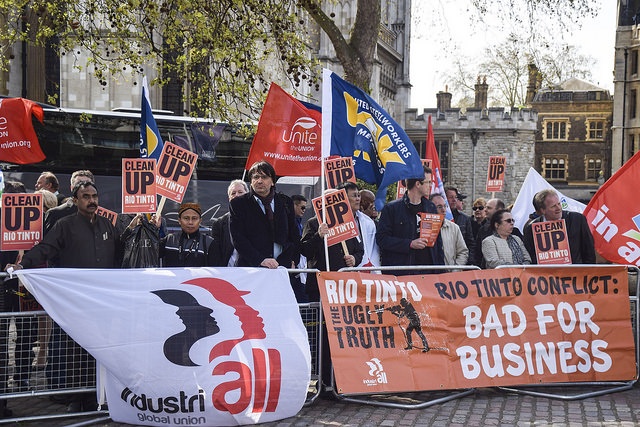30 April, 2015At Rio Tinto’s AGM in London on 16 April, Rio Tinto CEO Sam Walsh claimed that the company’s outsourcing strategy is all about responding to flexible market demands and accessing particular expertise. However, the global increase of the use of precarious labour at Rio Tinto in all regions of the world tells a different story.
Rio Tinto telling lies on precarious work?
During the AGM, Kemal Özkan, assistant general secretary of IndustriALL Global Union, took the floor and denounced Rio Tinto’s policy of outsourcing. Precarious workers at Rio Tinto have less job security, poorer working conditions and less social protection.
“There is no real benefit for Rio Tinto to this massive outsourcing. […] The reason for this business model with massive use of precarious labour is to weaken unions”.
Sam Walsh submitted apparently false reasons to justify their resort to outsourcing and precarious work.
“Outsourcing, […] is an area where clearly specific tasks [Rio Tinto] outsourced because of the particular expertise that one of our suppliers or a contractor company physically provides. It may be something that [Rio Tinto] need[s] periodically rather than regularly. And it’s the best and the most effective way of supplying that. Clearly there are times when [Rio Tinto] [has] surges and these are times when [Rio Tinto] need[s] to respond to a market up-turn […]. But let me assure you outsourcing is about giving this sort of flexibility this is not an anti-union strategy. It is more about the company recognizing the fact that in the business there are core functions that [the company] need[s] to provide [itself] and there are other you need to supplement with other expertise.” (Sam Walsh The annual general meeting for Rio Tinto plc, London April 2015)
Rio Tinto is not transparent about the use of precarious workers and does not disclose how many people work on sites it directly manages; it reports only direct employees. However a recent IndustriALL Global Union survey among affiliates representing workers at Rio Tinto’s fully or partially owned operations in 14 countries received answers in sharp contrast to Rio Tinto CEO’s claims.
Contractors [at IOC ] are not the skilled labourers you actually had, they replace our members on a constant basis. “ (Ron Thomas, President USW IOC Labrador responding to Sam Walsh at the Rio Tinto’s AGM in London)
Among unions surveyed, the percentage of precarious workers at Rio Tinto worksites is estimated to be as high as 70 per cent. Unions at Rio Tinto report that the company is increasing the use of precarious forms of employment. Over the last five to ten years, precarious work in France has increased from five to 25 per cent of the workforce. The use of precarious work at Grasberg (Indonesia) has doubled.
There is a clear strategy to replace important parts of the permanent workforce by outsourced or casual workers. At Rössing (Namibia), following retrenchments in 2013 and 2014 combined with outsourcing, ex–retrenched employees are now being contacted to work on six-month contracts.
At Rio Tinto’s coal mines in Australia, The Construction, Forestry, Mining and Energy Union (CFMEU) reports of Rio Tinto making permanent workers redundant while continuing to employ casual workers, replacing departing permanent workers with casual contractors and in some cases having an open policy of moving to a majority of outsourced workers.
In his response to Kemal Özkan’s statement, Sam Walsh said that Rio Tinto is
an organization who cares […] who offers good terms and conditions […]focused on health and safety.
However when resorting to precarious work, Rio Tinto generates inequalities among workers at its worksites. At Rio Tinto’s New Zealand and Alma smelters precarious workers reportedly earn 50 per cent less than direct employees. In addition, precarious workers generally have fewer benefits. Furthermore these workers are exposed to higher health and safety risks.
The fight against precarious work has become a central demand in IndustriALL Rio Tinto’s Campaign. IndustriALL latest publication Rio Tinto: The way it really works outlines the consequences of this increased use of precarious work.










